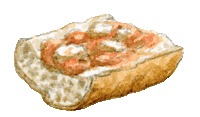Pa amb tomàquet or bread with tomato

Form: Open-faced sandwich
Country of origin: Spain
What distinguishes it from other methods of bread making: Open-faced sandwich usually toasted and rubbed with garlic, then with tomato, and seasoned with olive oil and salt
Category of bread: (9) Resembles Italian bruschetta
Particularity: Central to Catalan and Mallorcan cuisine
Ingredients: Open-faced sandwich made with pa de pages, a type of peasant bread (often unsalted); tomato; salt; olive oil

Spain
One mustn’t think that pa de pages, meaning literally “country bread,” does not suffice on its own. It can very well stand on its own and is extremely popular in Catalonia. But one day a fine bread maker brought back the old Spanish tradition of rubbing bread with olive oil and garlic, and adding his own twist.
A slice of toast, rubbed with garlic and tomato; the bread absorbs the tomato water. It is then sprinkled with salt and a trickle of olive oil is poured over it. The order in which the ingredients are added seems to have existed from time immemorial in Catalan cuisine, repeated over the centuries, and once the baker embellished it, it is written in marble. The Catalan open-faced sandwich, the pa amb tomàquet, then accompanies botifarra, a fresh Spanish sausage; chorizo; fuet, a pork sausage, dry-cured, like salami, as well as topped with Serrano ham, alongside marinated fish, grilled vegetables, etc.
The origins of this open-faced sandwich are obscure. Some see it as a symbol of local gastronomy, dating its origins way back in time. They like to think it’s always existed. But this hypothesis runs up against the fact that the Spanish only discovered tomatoes at the beginning of the 16th century; they brought them back from their explorations and conquests of the New World. It was also about the same time that the Italian bruschetta, incredibly similar to the Catalan open-faced sandwich, came into being.

